Grain Size-Related Strengthening and Softening of a Precompressed and Heat-Treated Mg–Zn–Ca Alloy
Abstract
1. Introduction
2. Materials and Methods
- Compression of the as-extruded state
- Tension of the as-extruded state
- Compression of heat-treated (16 h @ 150 °C) samples
- Tension of heat-treated (16 h @ 150 °C) samples
- Furthermore, samples have been precompressed up to 3% of plastic strain and subjected to
- Compression
- Tension
- A heat treatment of 16 h @ 150 °C followed by compression
- A heat treatment of 16 h @ 150 °C followed by tension
3. Results
4. Discussion
4.1. Effect of Extrussion Parameters
4.2. Effect of Heat Tratment
4.3. Effect of Precompression
4.4. Effect of Precompression and Heat Treatment
5. Conclusions
- Heat treatment (HT) at 150 °C for 16 h leads to strengthening and consequently to a slight increase in stress compared to the as-extruded condition within observed grain size interval.
- However, using HT after precompression, the strengthening effect is significantly higher compared to that observed after HT of extruded bars.
- At the same time, HT reduces the impact of detwinning on yielding during reversed tensile loading.
- Precompression up to 3% of plastic strain slightly decreased the compressive yield strength and distinctly reduced the tensile yield strength in comparison with the initial state. However, the Hall–Petch plot is similar throughout the observed grain size interval for both loading conditions.
- The strengthening effect caused by heat treatment applied after precompression is more pronounced in tension than in compression without any change in the Hall–Petch slope throughout the observed grain size interval. Thus, there is no grain size dependence of strengthening.
- Deformation-thermal processing leads to reverse tensile–compression yield asymmetry with higher strength values in compression. By comparison of the yield strength in the initial state with that observed after deformation-thermal processing, it is evident that the increasing grain size has a positive effect on compressive yield strength and also reduces negative effect on tensile yield strength due to the twinning–detwinning process.
Author Contributions
Funding
Conflicts of Interest
References
- Zander, D.; Zumdick, N.A. Influence of Ca and Zn on the microstructure and corrosion of biodegradable Mg–Ca–Zn alloys. Corros. Sci. 2015, 93, 222–233. [Google Scholar] [CrossRef]
- Cihova, M.; Martinelli, E.; Schmutz, P.; Myrissa, A.; Schäublin, R.; Weinberg, A.M.; Uggowitzer, P.J.; Löffler, J.F. The role of zinc in the biocorrosion behavior of resorbable Mg‒Zn‒Ca alloys. Acta Biomater. 2019, 100, 398–414. [Google Scholar] [CrossRef] [PubMed]
- Peron, M.; Torgersen, J.; Berto, F. Mg and Its Alloys for Biomedical Applications: Exploring Corrosion and Its Interplay with Mechanical Failure. Metals 2017, 7, 252. [Google Scholar] [CrossRef]
- Kainer, K.U. Magnesium Alloys and their Applications; Wiley-VCH Verlag GmbH: Weinheim, Germany, 2000. [Google Scholar] [CrossRef]
- Doležal, P.; Zapletal, J.; Fintová, S.; Trojanová, Z.; Greger, M.; Roupcová, P.; Podrábský, T. Influence of Processing Techniques on Microstructure and Mechanical Properties of a Biodegradable Mg-3Zn-2Ca Alloy. Materials 2016, 9, 880. [Google Scholar] [CrossRef]
- Horky, J.; Ghaffar, A.; Werbach, K.; Mingler, B.; Pogatscher, S.; Schäublin, R.; Setman, D.; Uggowitzer, P.J.; Löffler, J.F.; Zehetbauer, M.J. Exceptional Strengthening of Biodegradable Mg-Zn-Ca Alloys through High Pressure Torsion and Subsequent Heat Treatment. Materials 2019, 12, 2460. [Google Scholar] [CrossRef]
- Vinogradov, A.; Vasilev, E.; Kopylov, V.I.; Linderov, M.; Brilevesky, A.; Merson, D. High Performance Fine-Grained Biodegradable Mg-Zn-Ca Alloys Processed by Severe Plastic Deformation. Metals 2019, 9, 186. [Google Scholar] [CrossRef]
- Kittner, K.; Ullmann, M.; Henseler, T.; Kawalla, R.; Prahl, U. Microstructure and Hot Deformation Behavior of Twin Roll Cast Mg-2Zn-1Al-0.3Ca Alloy. Materials 2019, 12, 1020. [Google Scholar] [CrossRef]
- Dobron, P.; Drozdenko, D.; Olejnak, J.; Hegedus, M.; Horvath, K.; Vesely, J.; Bohlen, J.; Letzig, D. Compressive yield stress improvement using thermomechanical treatment of extruded Mg-Zn-Ca alloy. Mater. Sci. Eng. A 2018, 730, 401–409. [Google Scholar] [CrossRef]
- Dobroň, P.; Hegedüs, M.; Olejňák, J.; Drozdenko, D.; Horváth, K.; Bohlen, J. Influence of thermomechanical treatment on tension-compression yield asymmetry of extruded Mg-Zn-Ca alloy. In Proceedings of the TMS Annual Meeting & Exhibition 2019, San Antonio, TX, USA, 2019, unpublished work. [Google Scholar]
- Minárik, P.; Jablonská, E.; Král, R.; Lipov, J.; Ruml, T.; Blawert, C.; Hadzima, B.; Chmelík, F. Effect of equal channel angular pressing on in vitro degradation of LAE442 magnesium alloy. Mater. Sci. Eng. C 2017, 73, 736–742. [Google Scholar] [CrossRef]
- Bachmann, F.; Hielscher, R.; Schaeben, H. Texture Analysis with MTEX—Free and Open Source Software Toolbox. Solid State Phenom. 2010, 160, 63–68. [Google Scholar] [CrossRef]
- Nienaber, M.; Kainer, K.U.; Letzig, D.; Bohlen, J. Processing Effects on the Formability of Extruded Flat Products of Magnesium Alloys. Front. Mater. 2019, 6. [Google Scholar] [CrossRef]
- Barnett, M.R.; Davies, C.H.J.; Ma, X. An analytical constitutive law for twinning dominated flow in magnesium. Scr. Mater. 2005, 52, 627–632. [Google Scholar] [CrossRef]
- Stanford, N. Micro-alloying Mg with Y, Ce, Gd and La for texture modification-A comparative study. Mater. Sci. Eng. A Struct. Mater. Prop. Microstruct. Process. 2010, 527, 2669–2677. [Google Scholar] [CrossRef]
- Drozdenko, D.; Yamasaki, M.; Máthis, K.; Dobroň, P.; Lukáč, P.; Kizu, N.; Inoue, S.; Kawamura, Y. Optimization of mechanical properties of dilute Mg-Zn-Y alloys prepared by rapid solidification. Mater. Des. 2019, 181, 107984. [Google Scholar] [CrossRef]
- Mayama, T.; Noda, M.; Chiba, R.; Kuroda, M. Crystal plasticity analysis of texture development in magnesium alloy during extrusion. Int. J. Plast. 2011, 27, 1916–1935. [Google Scholar] [CrossRef]
- Partridge, P.G. The crystallography and deformation modes of hexagonal close-packed metals. Metall. Rev. 1967, 12, 169–194. [Google Scholar]
- Nie, J.F.; Muddle, B.C. Precipitation hardening of Mg-Ca(-Zn) alloys. Scr. Mater. 1997, 37, 1475–1481. [Google Scholar] [CrossRef]
- Drozdenko, D.; Čapek, J.; Clausen, B.; Vinogradov, A.; Máthis, K. Influence of the solute concentration on the anelasticity in Mg-Al alloys: A multiple-approach study. J. Alloys Compd. 2019, 786, 779–790. [Google Scholar] [CrossRef]
- Muransky, O.; Barnett, M.R.; Carr, D.G.; Vogel, S.C.; Oliver, E.C. Investigation of deformation twinning in a fine-grained and coarse-grained ZM20 Mg alloy: Combined in situ neutron diffraction and acoustic emission. Acta Mater. 2010, 58, 1503–1517. [Google Scholar] [CrossRef]
- Wang, H.; Lee, S.Y.; Wang, H.; Woo, W.; Huang, E.W.; Jain, J.; An, K. On plastic anisotropy and deformation history-driven anelasticity of an extruded magnesium alloy. Scr. Mater. 2020, 176, 36–41. [Google Scholar] [CrossRef]
- Zhang, H.; Jérusalem, A.; Salvati, E.; Papadaki, C.; Fong, K.S.; Song, X.; Korsunsky, A.M. Multi-scale mechanisms of twinning-detwinning in magnesium alloy AZ31B simulated by crystal plasticity modeling and validated via in situ synchrotron XRD and in situ SEM-EBSD. Int. J. Plast. 2019, 119, 43–56. [Google Scholar] [CrossRef]
- Bohlen, J.; Dobron, P.; Nascimento, L.; Parfenenko, K.; Chmelik, F.; Letzig, D. The Effect of Reversed Loading Conditions on the Mechanical Behaviour of Extruded Magnesium Alloy AZ31. Acta Phys. Pol. A 2012, 122, 444–449. [Google Scholar] [CrossRef]
- Drozdenko, D.; Bohlen, J.; Yi, S.; Minarik, P.; Chmelik, F.; Dobron, P. Investigating a twinning-detwinning process in wrought Mg alloys by the acoustic emission technique. Acta Mater. 2016, 110, 103–113. [Google Scholar] [CrossRef]
- Nie, J.-F. Precipitation and Hardening in Magnesium Alloys. Metall. Mater. Trans. A 2012, 43, 3891–3939. [Google Scholar] [CrossRef]
- Drozdenko, D.; Dobroň, P.; Yi, S.; Horváth, K.; Letzig, D.; Bohlen, J. Mobility of pinned twin boundaries during mechanical loading of extruded binary Mg-1Zn alloy. Mater. Charact. 2018, 139, 81–88. [Google Scholar] [CrossRef]
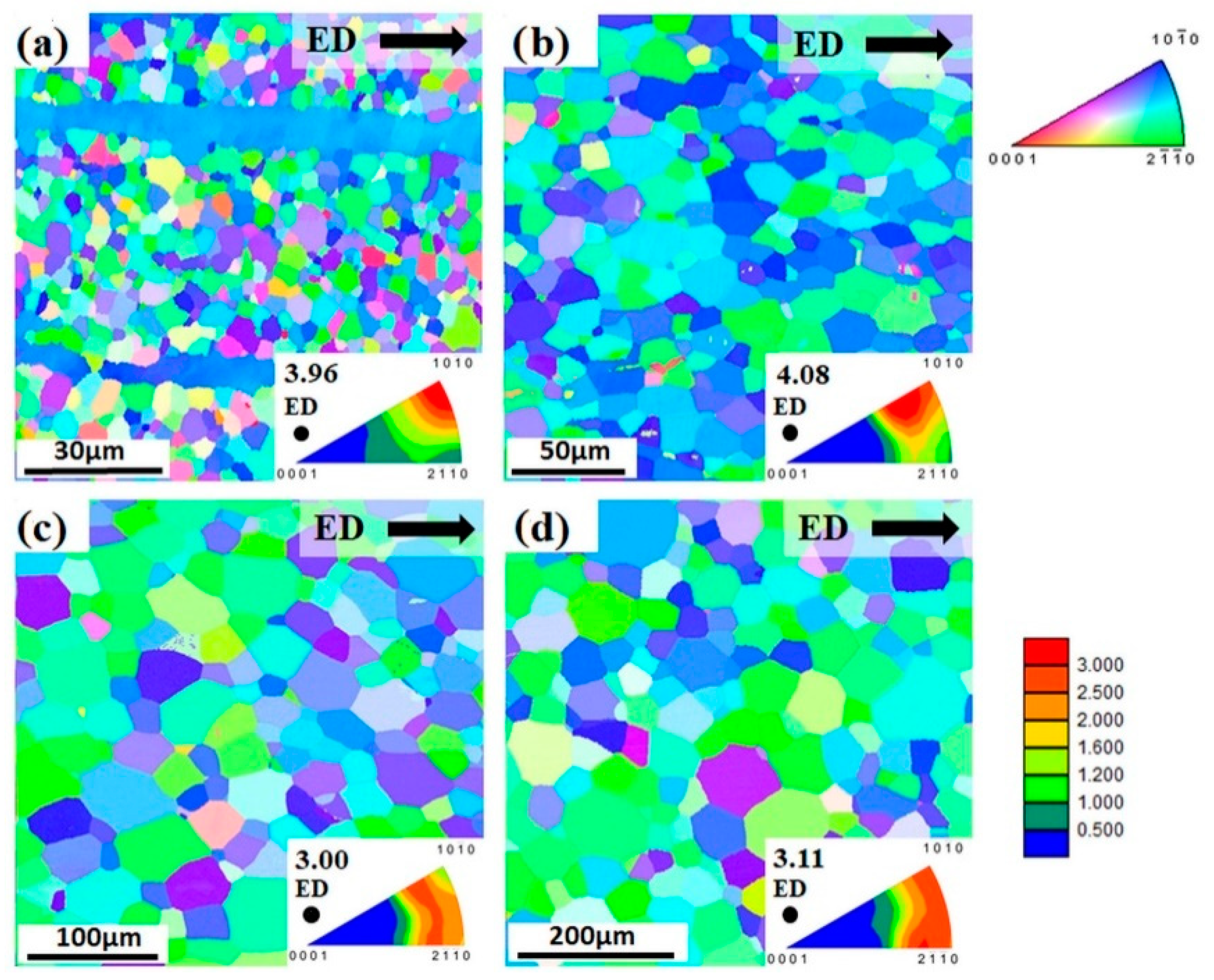
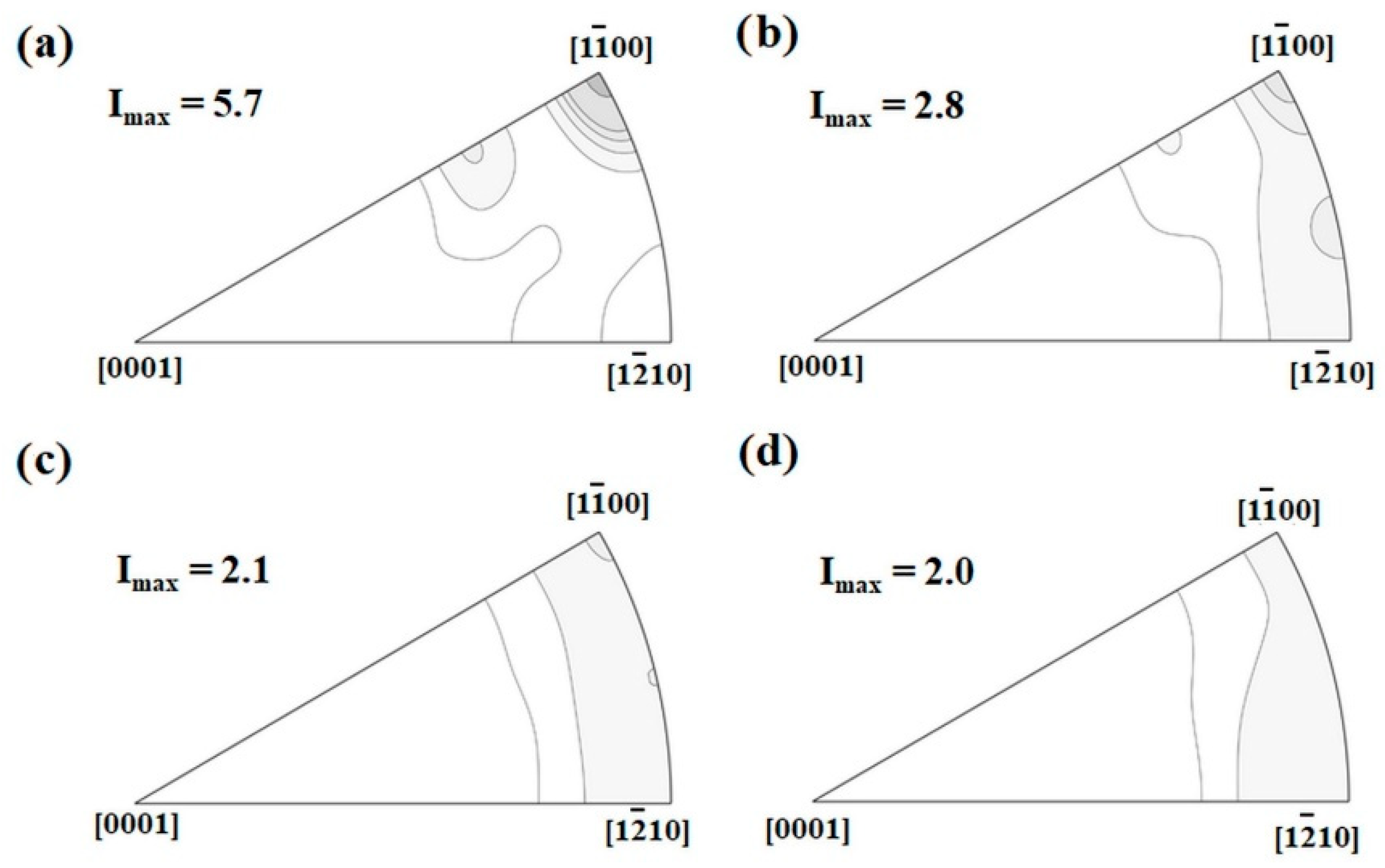
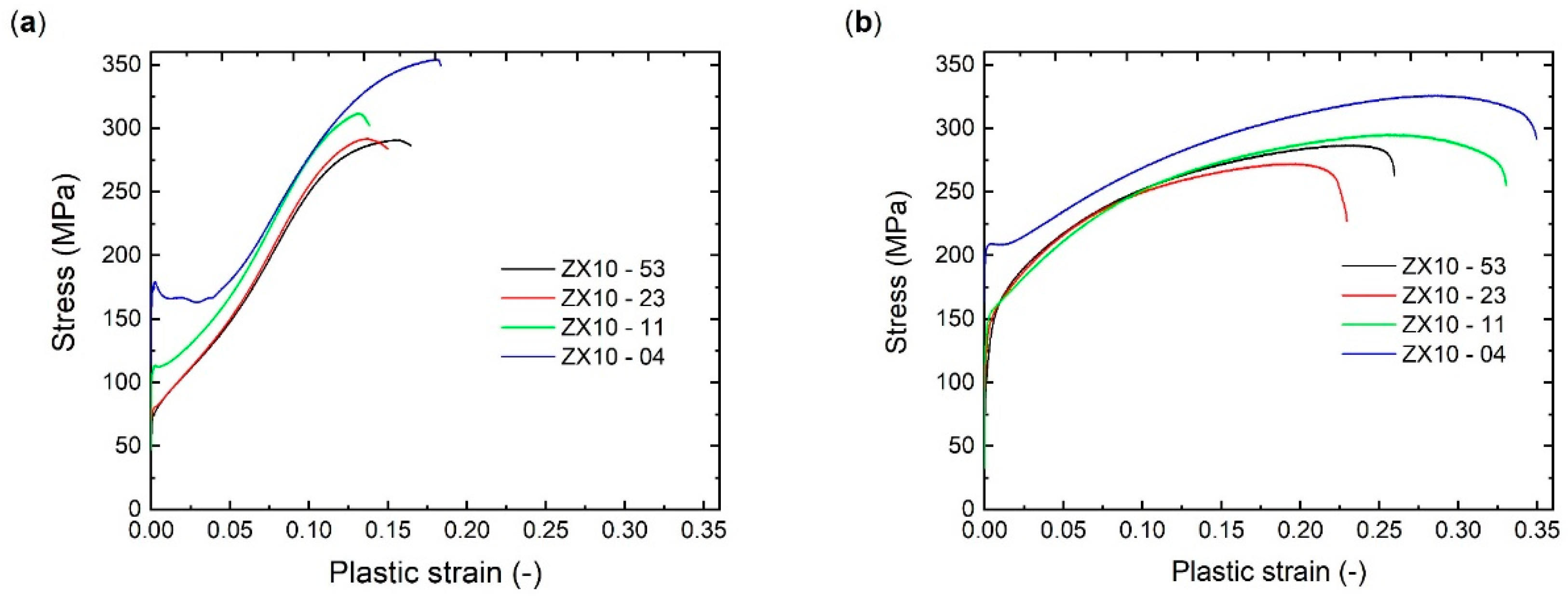
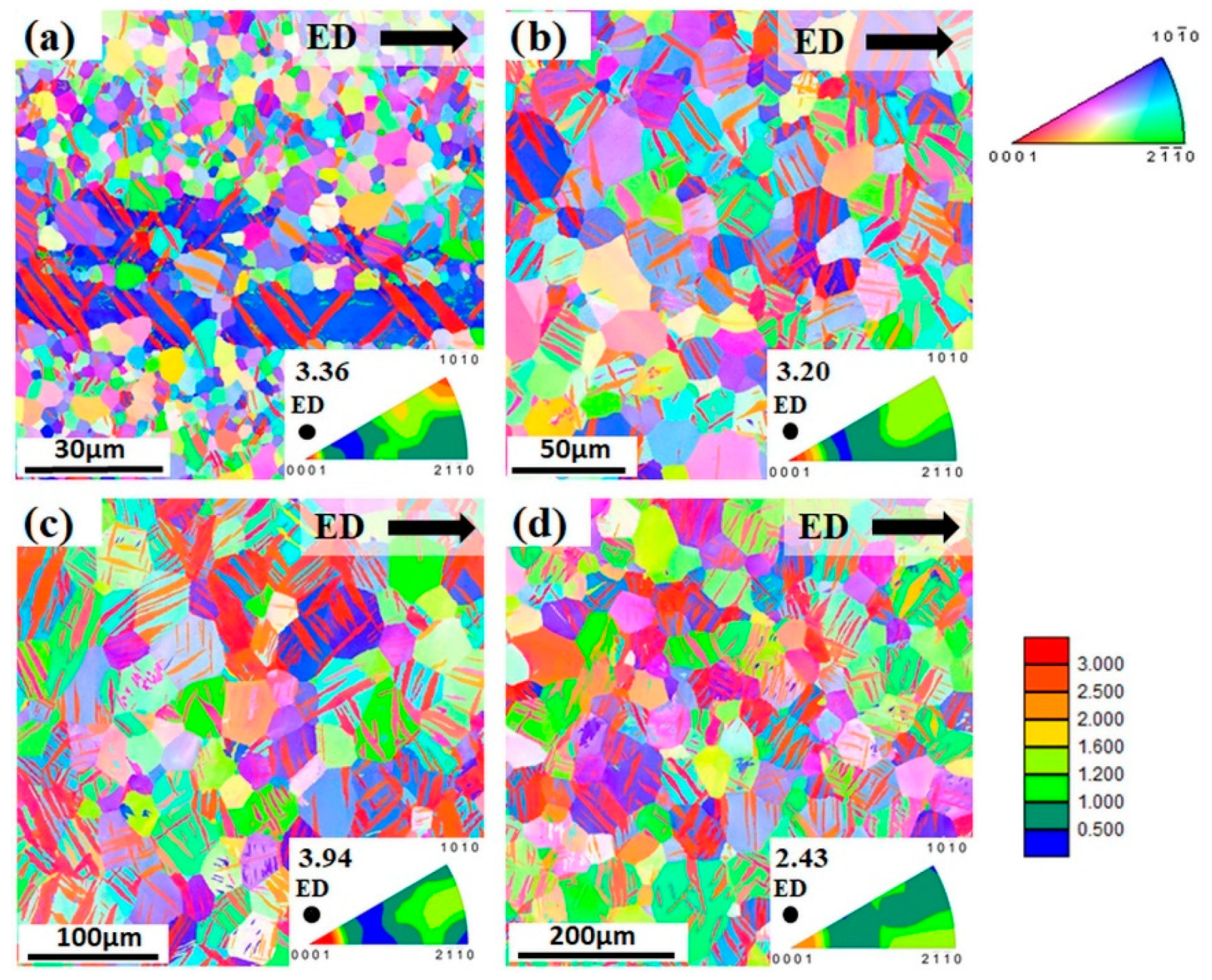

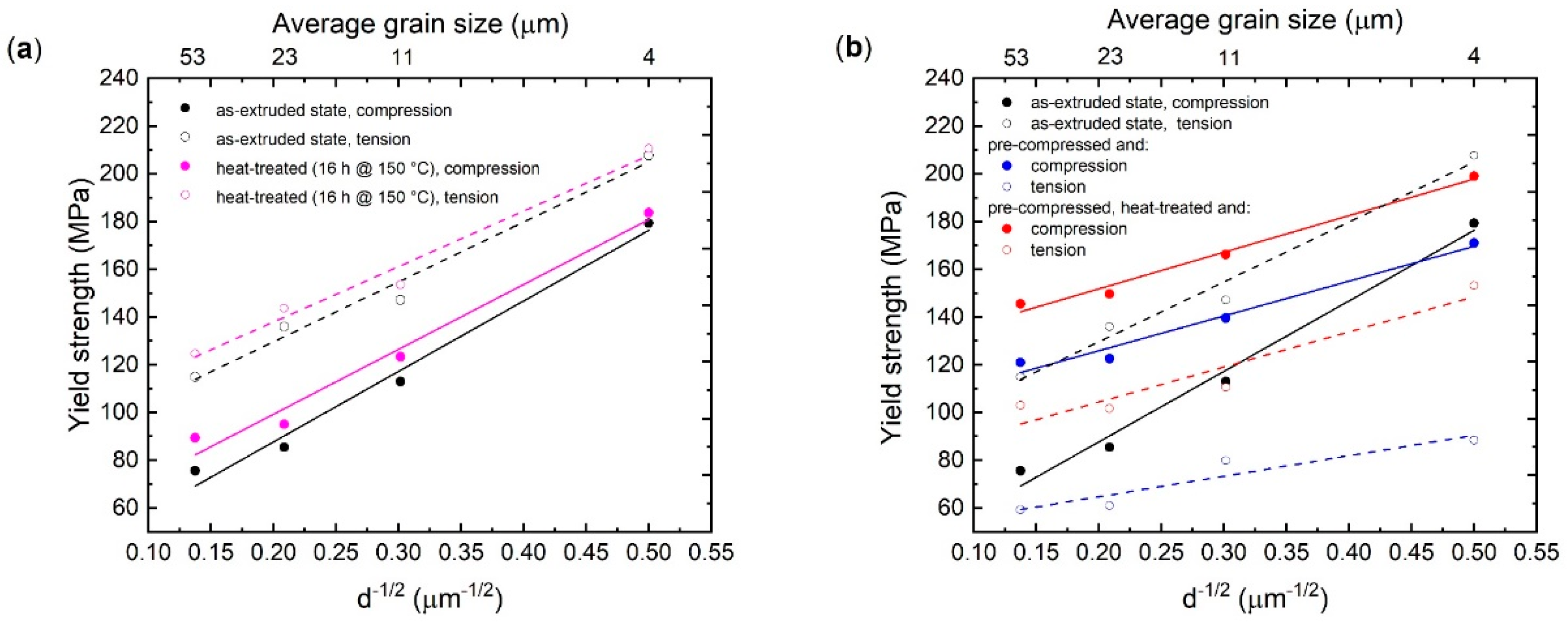
| Designation | As-Extruded | Heat-Treated | Precompressed | Precompressed and Heat-Treated |
|---|---|---|---|---|
| ZX10-04 | 29 | 27 | −83 | −46 |
| ZX10-11 | 34 | 31 | −60 | −55 |
| ZX10–23 | 48 | 46 | −62 | −48 |
| ZX10–53 | 39 | 36 | −62 | −43 |
© 2020 by the authors. Licensee MDPI, Basel, Switzerland. This article is an open access article distributed under the terms and conditions of the Creative Commons Attribution (CC BY) license (http://creativecommons.org/licenses/by/4.0/).
Share and Cite
Dobroň, P.; Drozdenko, D.; Horváth Fekete, K.; Olejňák, J.; Bohlen, J. Grain Size-Related Strengthening and Softening of a Precompressed and Heat-Treated Mg–Zn–Ca Alloy. Materials 2020, 13, 351. https://doi.org/10.3390/ma13020351
Dobroň P, Drozdenko D, Horváth Fekete K, Olejňák J, Bohlen J. Grain Size-Related Strengthening and Softening of a Precompressed and Heat-Treated Mg–Zn–Ca Alloy. Materials. 2020; 13(2):351. https://doi.org/10.3390/ma13020351
Chicago/Turabian StyleDobroň, Patrik, Daria Drozdenko, Klaudia Horváth Fekete, Juraj Olejňák, and Jan Bohlen. 2020. "Grain Size-Related Strengthening and Softening of a Precompressed and Heat-Treated Mg–Zn–Ca Alloy" Materials 13, no. 2: 351. https://doi.org/10.3390/ma13020351
APA StyleDobroň, P., Drozdenko, D., Horváth Fekete, K., Olejňák, J., & Bohlen, J. (2020). Grain Size-Related Strengthening and Softening of a Precompressed and Heat-Treated Mg–Zn–Ca Alloy. Materials, 13(2), 351. https://doi.org/10.3390/ma13020351





